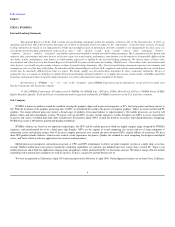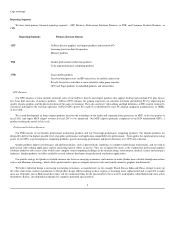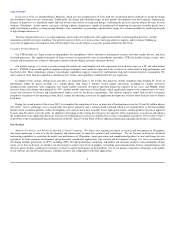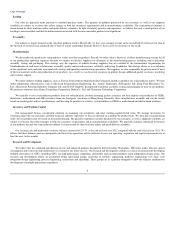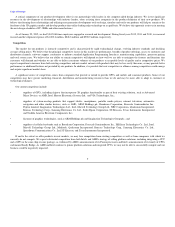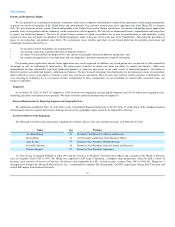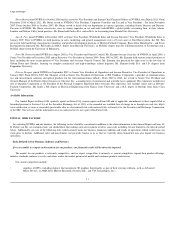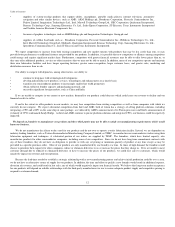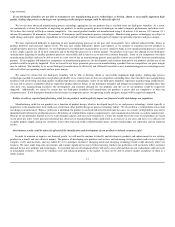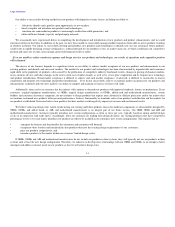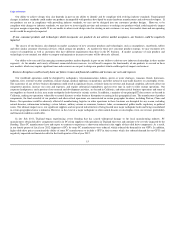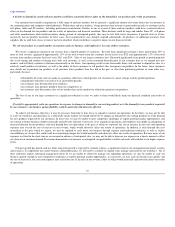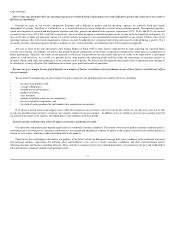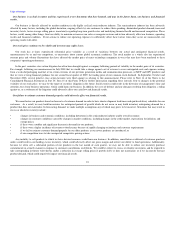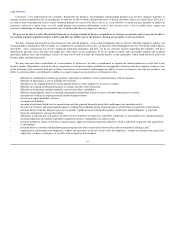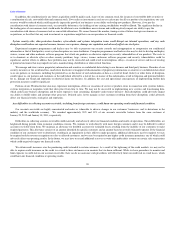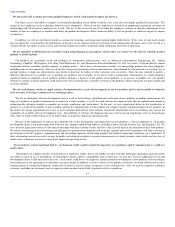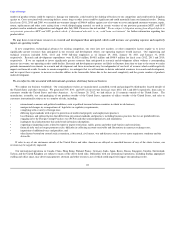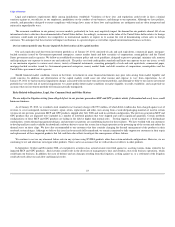NVIDIA 2012 Annual Report Download - page 14
Download and view the complete annual report
Please find page 14 of the 2012 NVIDIA annual report below. You can navigate through the pages in the report by either clicking on the pages listed below, or by using the keyword search tool below to find specific information within the annual report.
Table of Contents
If our third-party foundries are not able to transition to new manufacturing process technologies or develop, obtain or successfully implement high
quality, leading-edge process technologies our operating results and gross margin could be adversely affected.
We use the most advanced manufacturing process technology appropriate for our products that is available from our third-party foundries. As a result,
we continuously evaluate the benefits of migrating our products to smaller geometry process technologies in order to improve performance and reduce costs.
We believe this strategy will help us remain competitive. Our current product families are manufactured using 0.18 micron, 0.14 micron, 0.13 micron, 0.11
micron, 90 nanometer, 80 nanometer, 65 nanometer, 55 nanometer and 40 nanometer process technologies. Manufacturing process technologies are subject to
rapid change and require significant expenditures for research and development, which could negatively impact our operating expenses and gross margin.
We have experienced difficulty in migrating to new manufacturing processes in the past and, consequently, have suffered reduced yields, delays in
product deliveries and increased expense levels. We may face similar difficulties, delays and expenses as we continue to transition our new products to
smaller geometry processes. Moreover, we are dependent on our third-party manufacturers to invest sufficient funds in new manufacturing processes in order
to have ample capacity for all of their customers and to develop the processes in a timely manner. Our product cycles may also depend on our third-party
manufacturers migrating to smaller geometry processes successfully and in time for us to meet our customer demands. Some of our competitors own their
manufacturing facilities and may be able to move to a new state of the art manufacturing process more quickly or more successfully than our manufacturing
partners. If our suppliers fall behind our competitors in manufacturing processes, the development and customer demand for our products and the use of our
products could be negatively impacted. If we are forced to use larger geometric processes in manufacturing a product than our competition, our gross margin
may be reduced. The inability by us or our third-party manufacturers to effectively and efficiently transition to new manufacturing process technologies may
adversely affect our operating results and our gross margin.
We cannot be certain that our third-party foundries will be able to develop, obtain or successfully implement high quality, leading-edge process
technologies needed to manufacturer our products profitably or on a timely basis or that our competitors (including those that own their own manufacturing
facilities) will not develop such high quality, leading-edge process technologies earlier. If our third-party foundries experience manufacturing inefficiencies,
we may fail to achieve acceptable yields or experience product delivery delays. If our third-party foundries fall behind our competitors (including those that
own their own manufacturing facilities), the development and customer demand for our products and the use of our products could be negatively
impacted. Additionally, we cannot be certain that our third-party foundries will manufacture our products at prices that are competitive to what our
competitors pay. If our third-party foundries do not charge us competitive prices, our operating results and gross margin will be negatively impacted.
Failure to achieve expected manufacturing yields for our products could negatively impact our financial results and damage our reputation.
Manufacturing yields for our products are a function of product design, which is developed largely by us, and process technology, which typically is
proprietary to the manufacturer. Low yields may result from either product design or process technology failure. We do not know a yield problem exists until
our design is manufactured. When a yield issue is identified, the product is analyzed and tested to determine the cause. As a result, yield problems may not be
identified until well into the production process. Resolution of yield problems requires cooperation by, and communication between, us and the manufacturer.
Because of our potentially limited access to wafer foundry capacity and our recent transition to a wafer buy model where the costs of our products are based
on the price per wafer versus price per functional die, decreases in manufacturing yields could result in an increase in our costs and force us to allocate our
available product supply among our customers. Lower than expected yields could potentially harm customer relationships, our reputation and our financial
results.
Our business results could be adversely affected if the identification and development of new products is delayed or unsuccessful.
In order to maintain or improve our financial results, we will need to continue to identify and develop new products and enhancements to our existing
products in a timely and cost-effective manner. The process of developing new products and services and enhancing existing products and services is highly
complex, costly and uncertain, and any failure by us to anticipate customers' changing needs and emerging technology trends could adversely affect our
business. We must make long-term investments and commit significant resources before knowing whether our predictions will accurately reflect customer
demand for our new products and technologies. It is possible that our development efforts will not be successful and that our new technologies will not result
in meaningful revenues. Even if we introduce new and enhanced products to the market, we may not be able to achieve market acceptance of them in a
timely manner.
13



